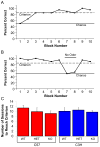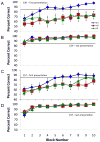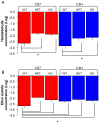Olfactory discrimination varies in mice with different levels of α7-nicotinic acetylcholine receptor expression
- PMID: 20713028
- PMCID: PMC2967370
- DOI: 10.1016/j.brainres.2010.08.027
Olfactory discrimination varies in mice with different levels of α7-nicotinic acetylcholine receptor expression
Abstract
Previous studies have shown that schizophrenics have decreased expression of α7-nicotinic acetylcholine (α7) receptors in the hippocampus and other brain regions, paranoid delusions, disorganized speech, deficits in auditory gating (i.e., inability to inhibit neuronal responses to repetitive auditory stimuli), and difficulties in odor discrimination and detection. Here we use mice with decreased α7 expression that also show a deficit in auditory gating to determine if these mice have similar deficits in olfaction. In the adult mouse olfactory bulb (OB), α7 expression localizes in the glomerular layer; however, the functional role of α7 is unknown. We show that inbred mouse strains (i.e., C3H and C57) with varying α7 expressions (e.g., α7 wild-type [α7+/+], α7 heterozygous knock-out [α7+/-] and α7 homozygous knock-out mice [α7-/-]) significantly differ in odor discrimination and detection of chemically-related odorant pairs. Using [(125)I] α-bungarotoxin (α-BGT) autoradiography, α7 expression was measured in the OB. As previously demonstrated, α-BGT binding was localized to the glomerular layer. Significantly more expression of α7 was observed in C57 α7+/+ mice compared to C3H α7+/+ mice. Furthermore, C57 α7+/+ mice were able to detect a significantly lower concentration of an odor in a mixture compared to C3H α7+/+ mice. Both C57 and C3H α7+/+ mice discriminated between chemically-related odorants sooner than α7+/- or α7-/- mice. These data suggest that α7-nicotinic-receptors contribute strongly to olfactory discrimination and detection in mice and may be one of the mechanisms producing olfactory dysfunction in schizophrenics.
Copyright © 2010 Elsevier B.V. All rights reserved.
Figures





Similar articles
-
α7-Nicotinic acetylcholine receptor: role in early odor learning preference in mice.PLoS One. 2012;7(4):e35251. doi: 10.1371/journal.pone.0035251. Epub 2012 Apr 13. PLoS One. 2012. PMID: 22514723 Free PMC article.
-
Altered hippocampal circuit function in C3H alpha7 null mutant heterozygous mice.Brain Res. 2008 Feb 15;1194:138-45. doi: 10.1016/j.brainres.2007.12.007. Epub 2007 Dec 8. Brain Res. 2008. PMID: 18199426 Free PMC article.
-
Alpha7-nicotinic receptor expression and the anatomical organization of hippocampal interneurons.Brain Res. 2001 Dec 20;922(2):180-90. doi: 10.1016/s0006-8993(01)03115-8. Brain Res. 2001. PMID: 11743948
-
Similarity and Strength of Glomerular Odor Representations Define a Neural Metric of Sniff-Invariant Discrimination Time.Cell Rep. 2019 Sep 10;28(11):2966-2978.e5. doi: 10.1016/j.celrep.2019.08.015. Cell Rep. 2019. PMID: 31509755 Free PMC article.
-
Effect of huprine X on β-amyloid, synaptophysin and α7 neuronal nicotinic acetylcholine receptors in the brain of 3xTg-AD and APPswe transgenic mice.Neurodegener Dis. 2010;7(6):379-88. doi: 10.1159/000287954. Epub 2010 Aug 4. Neurodegener Dis. 2010. PMID: 20689242
Cited by
-
Galantamine improves olfactory learning in the Ts65Dn mouse model of Down syndrome.Sci Rep. 2011;1:137. doi: 10.1038/srep00137. Epub 2011 Nov 2. Sci Rep. 2011. PMID: 22355654 Free PMC article.
-
Profound olfactory dysfunction in myasthenia gravis.PLoS One. 2012;7(10):e45544. doi: 10.1371/journal.pone.0045544. Epub 2012 Oct 17. PLoS One. 2012. PMID: 23082113 Free PMC article.
-
Cholinergic nervous system and glaucoma: From basic science to clinical applications.Prog Retin Eye Res. 2019 Sep;72:100767. doi: 10.1016/j.preteyeres.2019.06.003. Epub 2019 Jun 23. Prog Retin Eye Res. 2019. PMID: 31242454 Free PMC article. Review.
-
α7-Nicotinic acetylcholine receptor: role in early odor learning preference in mice.PLoS One. 2012;7(4):e35251. doi: 10.1371/journal.pone.0035251. Epub 2012 Apr 13. PLoS One. 2012. PMID: 22514723 Free PMC article.
-
Generation of mice lacking DUF1220 protein domains: effects on fecundity and hyperactivity.Mamm Genome. 2015 Feb;26(1-2):33-42. doi: 10.1007/s00335-014-9545-8. Epub 2014 Oct 12. Mamm Genome. 2015. PMID: 25308000 Free PMC article.
References
-
- Adler LE, Hoffer LD, Wiser A, Freedman R. Normalization of auditory physiology by cigarette smoking in schizophrenic patients. Am J Psychiatry. 1993;150:1856–1861. - PubMed
-
- Albuquerque EX, Pereira EF, Castro NG, Alkondon M, Reinhardt S, Schröder H, Maelicke A. Nicotinic receptor function in the mammalian central nervous system. Ann NY Acad Sci. 1995;757:48–72. - PubMed
Publication types
MeSH terms
Substances
Grants and funding
LinkOut - more resources
Full Text Sources
Molecular Biology Databases
Research Materials
Miscellaneous

